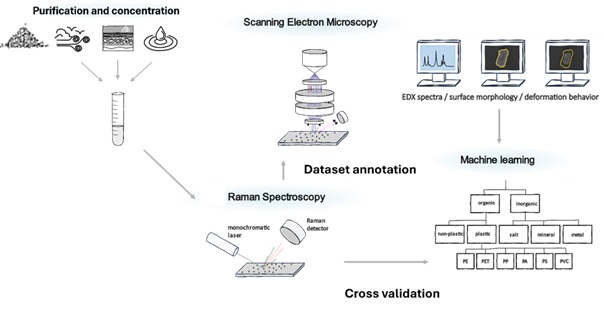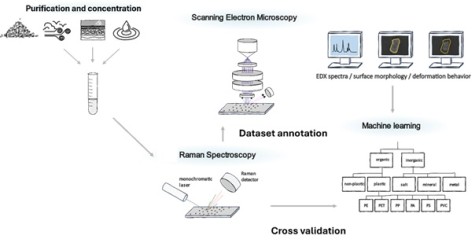Project start in October 2023
Nanoplastics – plastics less than 1,000 nanometers in size – are formed when larger pieces of plastic are broken down in the environment. These tiny plastic particles can be harmful to many organisms. They can be taken up by plants, penetrate cell membranes and thus enter cells. Today, it is still very difficult to determine the concentration of nanoplastics in the environment and to characterize all its properties. The project “Chemical/microscopic methods and AI for the analysis of nanoplastics” is about combining different analytical methods in order to allow detection and characterisation of nanoplastics in environmental matrices.
Individual methods used until today can each only generate incomplete information or only work for large nanoplastics. In particular, scanning electron microscopy (SEM) can provide high resolution images of nanoparticles but is lacking a chemical fingerprint measurement which allow for the identification of the polymers. Therefore, in the project funded through LOEWE Exploration, artificial intelligence will be used to assess if data collected with SEM on nanoplastics can differentiate nanoplastics from natural organic matter in environmental samples. A machine learning for particle classification is thus trained based on the annotated data generated by SEM. These data are relative elemental composition of the particles, particle and surphase morphology and particle deformation behavior in the electron beam. The annotation of the data nd the cross-validation of the results is then performed on particles > 500 nm using Raman spectroscopy and the results are extrapolated to particles <500 nm. The combination of the various chemical analytical and imaging methods with AI-based image recognition is novel, risky and unconventional.
With the developed method, it would be possible for the first time to fully characterize nanoplastics in environmental samples and obtain important information about the potential hazard of nanoplastics and its behavior in the environment. If successful, the developed method can be used in further projects and sustainably advance the research field


| PostDoc: | Dr. Alexandra Foetisch |
| Supervisor / PI: | Prof. Dr. Moritz Bigalke |
| Funding: | LOEWE Exploration |

